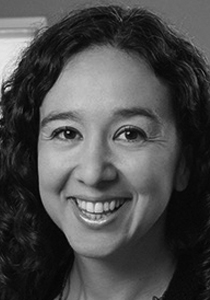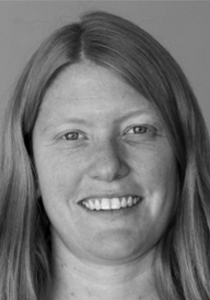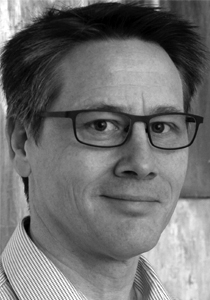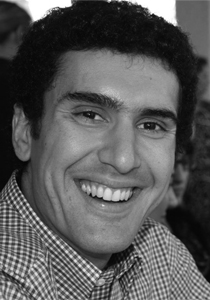Citation for Francina Dominguez

Francina Dominguez will receive the 2019 Atmospheric Sciences Ascent Award for her significant and fundamental contributions to the emerging field of terrestrial hydrometeorology, thereby significantly closing the gap between the atmospheric and hydrologic sciences, and for mentoring a new cadre of interdisciplinary scientists trained in the fundamentals of terrestrial hydrometeorology and its water management implications.
Francina’s research, as summarized in her nomination letter, is truly impressive. By choosing to study the atmosphere and the land surface as a “whole” (not just coupled) system, she was able to explore contributions of local evapotranspiration to regional precipitation and to thereby demonstrate how moisture cycles and recycles across the landscape. In addition, Francina has investigated the effects of climate variability and change on surface hydrology, projecting that future decreases in precipitation over the western United States will be accompanied by significant increases in extreme precipitation. These results led her to dig deeper into the physical mechanisms, such as atmospheric rivers (ARs). Some of her most recent work has demonstrated how large-scale atmospheric dynamics related to Rossby wave breaking can affect the formation of ARs and the manner in which they impinge into continental regions.
Besides being an exceptional scientist, Francina has pioneered the development of an educational curriculum for the emerging discipline of terrestrial hydrometeorology. At the University of Arizona, she codirected a newly formed academic program to bridge the traditional disciplines of hydrological and atmospheric sciences.
It is notable that Francina has achieved all of this while rearing a family—she is the proud mother of two young children. Because of the importance of her work, her generous personality, and her unparalleled ability to contribute to hydrometeorological understanding, Francina is richly deserving of the Ascent Award. On behalf of the AGU Atmospheric Sciences section, I am pleased to present the 2019 Ascent Award to Francina Dominguez.
—Hoshin Gupta, University of Arizona, Tucson
Response
I am very grateful to receive the 2019 AGU Ascent Award. My life has taken many twists and turns since I was a civil engineering consultant in Colombia, freshly out of college. In hydrometeorology, I found a deeply satisfying combination of basic physical understanding of the land–atmosphere system with practical applications. I feel grateful to both the University of Illinois and the University of Arizona. The former institution welcomed me as a graduate student into the Civil and Environmental Engineering (CEE) Department, and then again 15 years later as faculty in the Department of Atmospheric Sciences, working with students and colleagues who make work both interesting and fun. The latter institution is where I became a hydrometeorologist, in what is now the Department of Hydrology and Atmospheric Sciences (HAS).
I would like to thank three friends and colleagues who have shaped my career. Praveen Kumar, from the University of Illinois CEE department, my graduate advisor and mentor, welcomed me into his group almost 20 years ago and has encouraged, challenged, and supported me ever since. Hoshin Gupta, from the University of Arizona’s HAS department, has provided unwavering support and opened my mind to new ideas and ways to think about science. And Ying Fan Reinfelder, from Rutgers University, whom I admire deeply, has inspired me by asking the hardest simple questions and relentlessly answering them.
I especially thank my husband, Sandy, who has supported and encouraged me. That we have somehow managed to simultaneously have two fulfilling careers and rear two girls never ceases to amaze me. And, finally, I thank my brilliant and funny brother, Arturo; my mother, Guiomar, the steadfast and fearless woman I always strive to imitate; and my father, Camilo, the ever curious absentminded scientist who reminds me of me.
—Francina Dominguez, University of Illinois at Urbana-Champaign
Citation for Jennifer Murphy

Jennifer Murphy will receive the Atmospheric Sciences Ascent Award for her significant contributions to our understanding of the processes controlling the abundance of important tropospheric trace species. Jen has worked extensively in the field of reactive nitrogen chemistry. She is a world leader in the measurement of atmospheric ammonia, deploying novel instrumentation at the ground and on aircraft and ships. She is a leading proponent for the importance of bidirectional exchange of ammonia between the atmosphere and the Earth’s surfaces. She has illustrated that nitrous acid also undergoes surface exchange via acid–base processes. Jen demonstrated the importance of ammonia in remote regions by measuring high mixing ratios in the Canadian Arctic. In collaboration with modelers, she showed that Arctic bird colonies were the source of ammonia, which has a major impact on aerosol particle formation, neutralization, and cloud interactions. She has also demonstrated that the same aerosol neutralization process dominates the aerosol loading in some polluted wintertime environments. Jen actively interfaces with the biogeochemistry community, studying atmosphere–biosphere exchange of the oxides of nitrogen in forested environments and the budgets of methane and carbon dioxide in a variety of North American settings.
Jen’s research is conducted largely in the field, where she is known for her ability to make high-quality measurements via the deployment of advanced instrumentation. She is a highly valued collaborator contributing to the development of field campaign research plans and hypotheses. Jen has also demonstrated substantial scientific leadership both in Canada and in the larger international atmospheric chemistry community, for example, through her membership on the International Global Atmospheric Chemistry Scientific Steering Committee. As a midcareer scientist, her commitment to the training of emerging scientists is notable, with many former students now employed in academia and beyond.
—Jonathan Abbatt, University of Toronto, Toronto, Ont., Canada
Response
I am delighted and honored to receive this award and feel very fortunate to be a member of a research community that has been so supportive of my career. Having been involved in atmospheric chemistry research for almost 20 years, I recognize that it has been a great match for my curiosity, enthusiasm, and sense of adventure. Even more, it has provided opportunities to perform research alongside so many talented, inspiring, and generous colleagues and collaborators.
During my Ph.D. in the Department of Chemistry at University of California, Berkeley, I worked with Ronald Cohen, whose incisive approach to research was a wonderful model. I was also fortunate to be part of a cohort of bright and energetic students and postdocs who have continued to be valued colleagues and friends. As a faculty member at the University of Toronto since 2007, I have benefited tremendously from the remarkable environmental chemistry community, composed of many faculty, postdoctoral fellows, and graduate students. In particular, Jon Abbatt has been a wonderful mentor, advocate, and collaborator. I am grateful to the graduate and undergraduate students and postdoctoral fellows who have worked with me over the past 13 years. They have contributed greatly to all the accomplishments mentioned in the citation and to the sense of enjoyment and wonder that makes a career in academic research so enjoyable.
—Jennifer Murphy, University of Toronto, Toronto, Ont., Canada
Citation for David Noone

David Noone is a pioneer in applications of stable isotope tracers toward understanding of the water and carbon cycles. His work has forged foundations for the wider use of stable isotope information in atmospheric and climate science.
Early in his career, David established that interpretation of isotope proxy data required an accounting for the underlying meteorological processes. He recognized that to quantitatively invert the isotope signals, detailed process models to track the isotope ratios were required. David is well known for his leading work simulating the stable isotope ratios in global climate models and using these to evaluate the dynamics of atmospheric moisture filaments with isotopic information to identify water origins and atmospheric water recycling. David has continued to champion the applications of stable water isotopes on a variety of timescales, including refining, improving, and incorporating them into the latest National Center for Atmospheric Research models.
Not content to base his knowledge of stable water isotopes on just theory and modeling, David established the use of satellite observations of isotope ratios to describe water cycles. With the advent of refined optical measurement techniques, he developed studies that use in situ measurements of isotope ratios at sites around the world from the ground, at sea, and in the air to resolve poorly known processes. His team’s “meteorological” measurements of the isotope ratio of water vapor at the Mauna Loa Observatory helped establish the utility of measurements of water isotopologues as an important metric of climate change.
David’s substantial impact on the field of atmospheric and climate science is exemplified by the large number of early-career scientists he has mentored on combining models and observations for understanding present and past climates. These are our next generation of scientists who will continue to use the additional insights of water isotopologues to decipher past and future climate change.
—Bette Otto-Bliesner, National Center for Atmospheric Research, Boulder, Colo.
Response
It is a great honor to receive this award. Like many, I was fortunate to have stumbled upon a career path and research area that I find addictive. The little puzzles that nature provides continue to be irresistible. I delight in finding ways the little puzzles help bring order to the larger mysteries of the world.
Receiving this award offers a moment for introspection, and one is always reminded that accomplishments are not made in isolation. I use this moment to thank all my students, collaborators, and even anonymous reviewers, who help enable a scholarly existence where creativity and thoughtfulness can be brought to bear on the work we do together.
I was once asked whether there was a particular schoolteacher who had inspired me. I answered, “no.” The remarkable truth that underlies the terse response is that I had a continual string of mentors, from a very early age continuing to this day, all of whom were astonishing. All of my teachers prompted me to look a little harder or try something a little different: I think of an elementary school teacher who fooled me into three-dimensional geometry with origami, a high school teacher who patiently watched my feeble efforts to balance rotational forces on the pottery wheel, and university advisers who pointed me to piles of particularly prickly problems and trained me in the technical tools to tackle them with. I’m pleased to report that I’m still trying to master most of the lessons that they assigned.
Maintaining the unbroken chain of education is a responsibility. Science is not just the cold, hard reality of numbers but is also an enterprise that succeeds because we build together. I keep learning from my students, who persistently push me to help find clarity to think through new ideas. Perhaps they too are developing an addiction for nature’s puzzles.
—David Noone, Oregon State University, Corvallis
Citation for Armin Sorooshian

Armin Sorooshian is uniformly cited as one of the most important scholars worldwide in the field of aerosol–water relationships. He is the author of 123 peer-reviewed journal publications (including 41 papers in AGU journals). Early in his career, he was instrumental in bringing the Particle-into-Liquid Sampler (PILS) into the sphere of aircraft studies. He developed the Differential Aerosol Sizing and Hygroscopicity Spectrometer Probe (DASH-SP), the first instrument capable of measuring size-resolved aerosol hygroscopicity with fast time resolution. He also developed a novel Counterflow Virtual Impactor (CVI) inlet for airborne platforms to preferentially sample and evaporate cloud droplets to yield residual particles. Armin’s airborne measurements with the PILS and CVI instruments advanced knowledge of how clouds redistribute particles and modify aerosol composition. He was instrumental in unraveling the processes involved in the production of secondary organic aerosol by aqueous droplet chemistry. His work with the DASH-SP was important in several Navy and NASA airborne missions to advance understanding of aerosol hygroscopic properties. As a postdoctoral fellow with Graham Feingold, Armin used a combination of models, satellite data, and in situ observations to study the precipitation susceptibility of clouds to aerosol perturbations. He has been a leader in airborne fieldwork, as demonstrated by his being a principal investigator with the Navy Twin Otter aircraft in 15 airborne field projects. Armin’s impact in coming years will continue to grow, as evidenced by his having been selected recently as the principal investigator of the Aerosol Cloud Meteorology Interactions over the Western Atlantic Experiment (ACTIVATE), a $30-million NASA Earth Venture Class suborbital mission directed toward understanding aerosol–cloud–meteorology interactions over the western North Atlantic Ocean that will be carried out off the U.S. East Coast during 2019–2023. Furthermore, Armin has trained an impressive group of upcoming researchers in chemical engineering, atmospheric sciences, and public health.
—John H. Seinfeld, California Institute of Technology, Pasadena
Response
I am deeply honored to receive the Ascent Award and am in debt to everyone who has had an impact on my career, including remarkable advisors, a wonderful group of graduate students, and my family. I extend appreciation to my nominators and the selection committee. It is with sadness that the atmospheric sciences community felt a great loss as Fuqing Zhang, my principal nominator, passed away recently. The impact felt by his students and the scientific community from his career’s efforts will continue to be strong. My first role model in academia was my father, who is the reason I chose this profession and from whom I still learn by observation. My Ph.D. advisors, John H. Seinfeld and Richard C. Flagan, gave me remarkable opportunities and taught me by example how to be a mentor. Their trust in me during airborne field projects was significant, as I had the inspiring experience of being a flight scientist during Navy Twin Otter missions. My luck with excellent mentors continued with my postdoctoral advisor, Graham Feingold, who inspired me with his creativity, passion for clouds, and genuine desire to support junior scientists. Other significant mentors throughout my career that I thank include Haflidi Jonsson, Graeme Stephens, Eric Betterton, and Xubin Zeng. I want to acknowledge the Office of Naval Research and NASA, who have supported the majority of my research. A very special group of people I share this award with and for whom I am very thankful are my former and current graduate students from the University of Arizona, each of whom I am proud and lucky to have been able to advise. Last, I thank those who have been the constants throughout my career: my parents, Soroosh and Shirin; my brother, Jamshid; my wife, Atria; and our son, Parsa.
—Armin Sorooshian, University of Arizona, Tucson
Citation for Rainer M. Volkamer

Rainer Volkamer is recognized worldwide as an expert at the interface of field observations, laboratory experiments, and chemical modeling of molecular processes by which atmospheric radicals and trace substances affect air quality and climate. He has developed micrometeorological and remote sensing instruments to better quantify emissions from the ocean surface and wildfires, as well as attributed methane emissions to agriculture and oil and gas production.
Rainer first became well known from differential optical absorption spectroscopy observations of glyoxal, identifying this product from the atmospheric oxidation of hydrocarbons as an important precursor of organic aerosol. During his Ph.D., he advanced our understanding of aromatic hydrocarbon oxidation and helped develop the Master Chemical Mechanism, the world’s repository of knowledge for quantitative atmospheric chemical kinetics. He established the molecular spectroscopy of glyoxal in the laboratory, pioneered its remote sensing from satellites, detected glyoxal in Mexico City, Mexico, and measured the first eddy covariance fluxes of glyoxal over oceans that point to a source in the sea surface microlayer. Global satellite maps of glyoxal are produced today by research teams in Europe and in the United States and are used to identify hot spots of hydrocarbon chemistry in the atmosphere, evaluate global models, predict aerosol formation, and infer sources of hydrocarbons that cannot be measured directly, thanks to Rainer’s pioneering work. His research group’s halogen measurements in the marine boundary layer and in the upper troposphere and lower stratosphere feature prominently in the World Meteorological Organization’s 2018 ozone assessment report and have led to revised estimates of total inorganic iodine injection into the stratosphere, where iodine participates in the destruction of stratospheric ozone.
Rainer has published over 100 research papers, many of which are highly cited and of high impact. In 2014, he was named a highly cited researcher in the geosciences by Thomson Reuters. He also shows remarkable leadership and service to the community by designing and leading major aircraft field campaigns such as the Tropical Ocean Troposphere Exchange of Reactive Halogens and Oxygenated Hydrocarbons (TORERO) project and the Biomass Burning Flux Measurements of Trace Gases and Aerosols (BB-FLUX) project. Rainer is also an excellent teacher and mentor, and several of his students and postdocs have already started promising careers. He is highly deserving of the AGU Ascent Award.
—Jose L. Jimenez, University of Colorado Boulder
Response
I am deeply honored to receive the 2019 AGU Ascent Award. My gratitude goes to the nominators and the selection committee for this humbling and wonderful recognition.
Over the years, I have had the great pleasure to learn from individuals committed to excellence with whom I share a passion for atmospheric chemistry and climate and their interactions. I specifically thank my Ph.D. advisor, Ulrich Platt (University of Heidelberg, Germany); early mentors Mike Pilling (University of Leeds, United Kingdom), Klaus Wirtz (Fundación Centro de Estudios Ambientales del Mediterráneo, Spain), and Paul Crutzen (Max Planck Institute, Mainz, Germany); and my postdoctoral advisors, Mario J. Molina (Massachusetts Institute of Technology (MIT) and University of California, San Diego) and Luisa Tang Molina (MIT and the Molina Center for Energy and the Environment (MCE2)), who have not only set me on my current trajectory but also instilled in me as mentors a desire to venture into new (applied) research fields with an eye on fundamentals. The support from my colleagues in the Department of Chemistry and the Cooperative Institute for Research in Environmental Sciences, and funding from the National Science Foundation, Electric Power Research Institute, U.S. Department of Energy, NASA, Colorado Department of Public Health and Environment, California Air Resources Board, and the European Union, have been key to my accomplishments since starting at the University of Colorado Boulder in 2007. And I have benefited greatly from the energy and insights from many friends and colleagues that I am lucky enough to call collaborators.
Most of all, I share this recognition with the postdoctoral scholars, scientists, graduate students, and undergraduates who have worked with me over the years. Without them, the achievements mentioned in the citation would not have happened and, most of all, would not have been nearly as much fun. I look forward to continuing to work with such talented young scientists to better understand atmospheric interactions of natural and managed ecosystems in the future.
Finally, I thank my wife, Carmen, and our two children, Rafael and Joana, for their unconditional love and support. I dedicate this award to adventurous Grandma Helga, who joined us during fieldwork in Costa Rica.
—Rainer M. Volkamer, University of Colorado Boulder
Citation:
(2020), Dominguez, Murphy, Noone, Sorooshian, and Volkamer receive the 2019 Atmospheric Sciences Ascent Award, Eos, 101, https://doi.org/10.1029/2020EO136758. Published on 25 March 2020.
Text © 2020. AGU. CC BY-NC-ND 3.0
Except where otherwise noted, images are subject to copyright. Any reuse without express permission from the copyright owner is prohibited.
